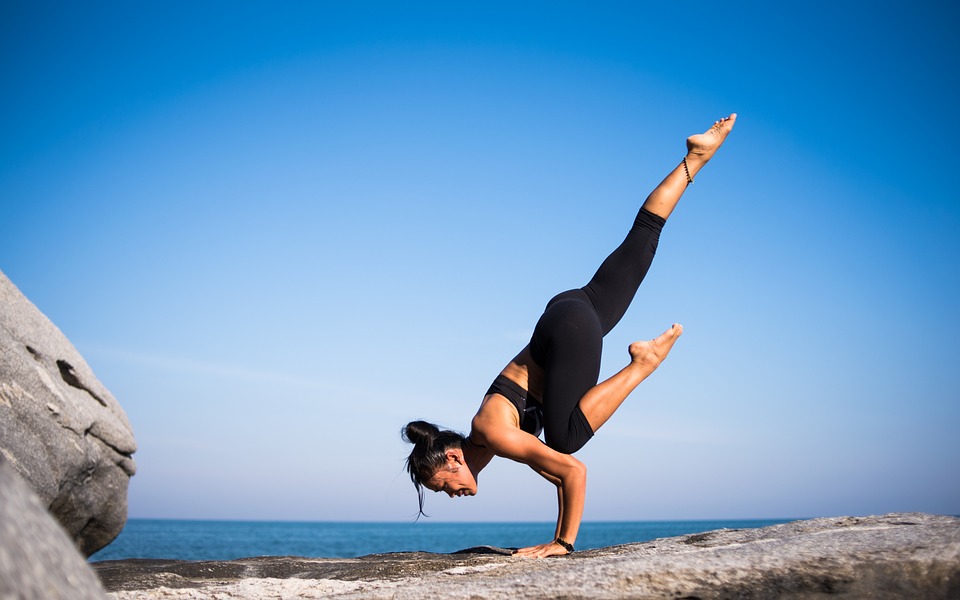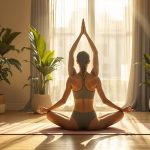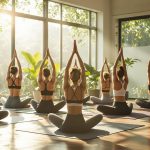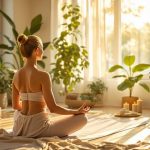
Imagine anxiety as a stormy sea, and yoga as the anchor that keeps your ship steady amidst the waves. You’re about to discover 10 yoga routines that act as this anchor, guiding you towards calmness and resilience. Each routine offers a unique blend of poses and breathwork to calm your nervous system and ease the burden of anxiety. As you explore these practices, you’ll find ways to integrate mindfulness and relaxation into your daily life. Feel intrigued about which specific techniques can make a real difference for you? Let’s explore how these practices can transform your storm into tranquility.
Benefits of Yoga for Anxiety
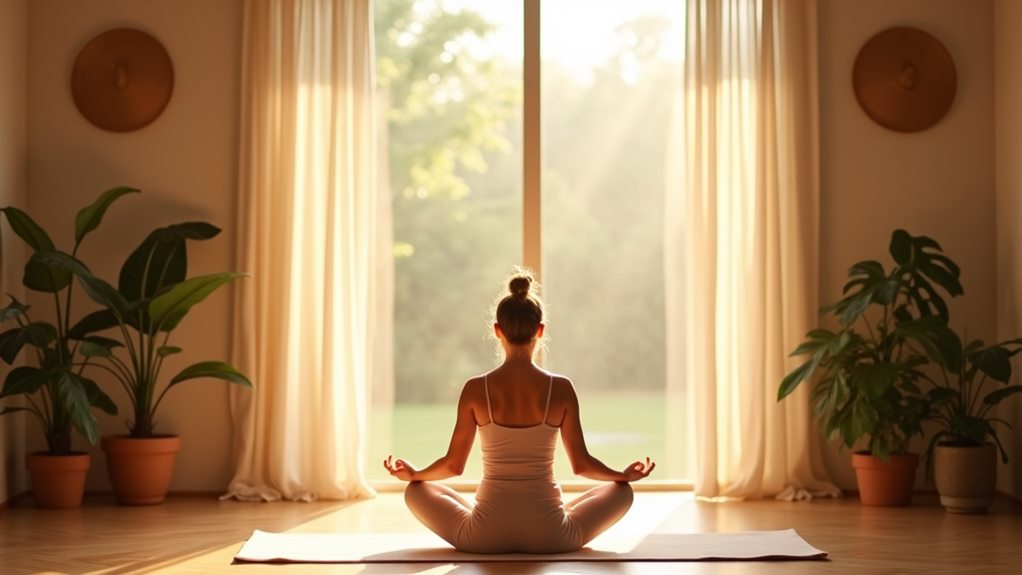
Amid various therapeutic approaches to anxiety, yoga emerges as a unique method to combat stress.
It’s worth noting that Tai Chi also shares similar benefits, offering a holistic approach to enhance mental and physical well-being. When you practice yoga regularly, you can substantially reduce stress and anxiety levels. This reduction happens because yoga decreases the production of stress hormones like cortisol and adrenaline.
By engaging in yoga, you promote emotional regulation, which can lead to reduced emotional reactivity and improved mood stability. This is vital for maintaining ideal mental health.
Yoga goes beyond just physical postures; it incorporates breathing techniques that stimulate your vagus nerve, helping regulate stress responses. This stimulation enhances your body’s ability to relax and recover from stress, making it a valuable tool for anxiety management.
Practicing mindfulness during yoga increases your self-awareness, allowing you to better recognize and manage anxiety symptoms effectively.
Additionally, yoga is known to improve sleep quality, particularly important for those prone to anxiety. Quality sleep contributes greatly to overall mental health and well-being, providing you with the necessary rest to face daily challenges.
Incorporating yoga into your routine can provide a holistic approach to anxiety relief, promoting relaxation and emotional regulation, and ultimately enhancing your overall mental health.
Key Yoga Poses for Calmness
Incorporating key yoga poses into your routine can greatly enhance relaxation and calmness. When practiced mindfully, these poses can help relieve anxiety symptoms and promote a peaceful state of mind.
Practicing these poses consistently, tailored to your individual needs, can also improve mood, energy, and sleep quality. Consider these effective yoga poses for anxiety:
1. Child’s Pose: As a foundational pose, this gently stretches the back, hips, and thighs. It promotes relaxation and eases stress, helping you find calmness by aligning your mind and body.
Focus on deep breathing to maximize its calming effects.
2. Legs-Up-the-Wall Pose: Known for relieving tension and anxiety, this pose helps calm the nervous system by reversing blood flow. It’s perfect for those moments when you need a break and want to promote relaxation from within.
Hold for up to 15 minutes for optimum benefits.
3. Seated Forward Bend: By stretching the spine and hamstrings, this pose calms the mind and offers introspection. It’s a brilliant way to help relieve anxiety by encouraging a state of soothing stillness.
Embrace deep breathing while you hold it for up to 5 minutes.
4. Triangle Pose: It eases neck and back tension and promotes grounding and stability.
Holding it for up to 1 minute on each side fosters calmness and focus.
Breathwork Techniques in Yoga
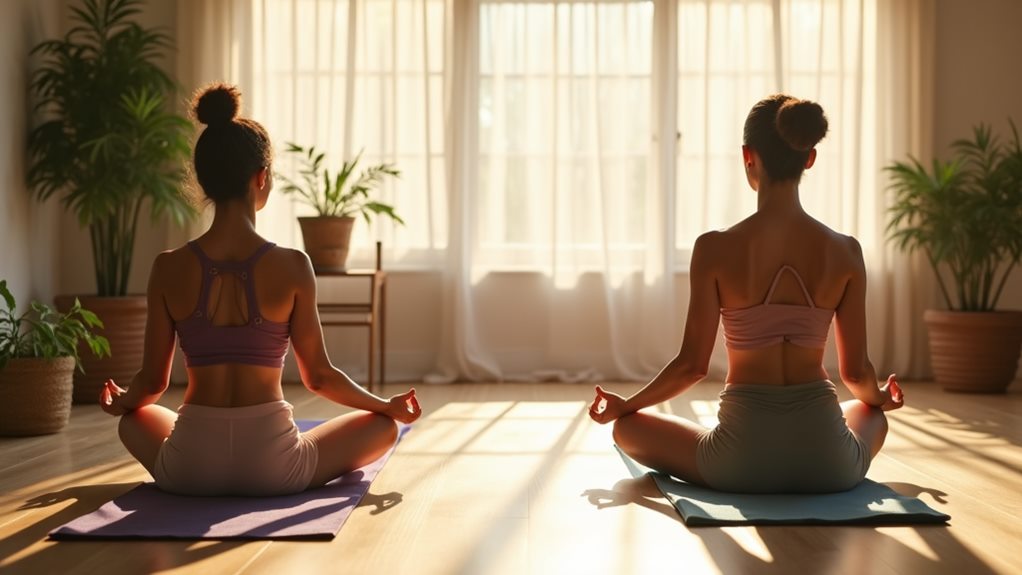
While practicing key yoga poses can help calm the mind, integrating breathwork techniques greatly increases the effects on anxiety relief. Breathwork, or pranayama, plays an essential role in regulating your nervous system. Simple techniques, like deep diaphragmatic breathing and lengthening your exhalations, can lower cortisol levels and instantly ease anxiety symptoms. A highly effective method is Nadi Shodhana, or alternate nostril breathing, which balances your body’s energy channels and brings about profound mental calmness.
Mindful breathing practices don’t just promote relaxation; they enhance your interoception—your awareness of bodily sensations and emotional states—helping you manage anxiety more effectively. Counting breaths or deep sighs can sharpen focus and improve mental clarity, contributing to a state of heightened relaxation and reduced anxiety.
Here’s a brief insight into some techniques:
| Technique | Purpose | Benefit |
|---|---|---|
| Deep Breathing | Nervous system regulation | Immediate anxiety relief |
| Nadi Shodhana | Balance energy channels | Calms mind, balances body |
| Mindful Breathing | Heightens interoception | Enhances focus, promotes relaxation |
| Long Exhales | Reduce stress hormones | Eases anxiety symptoms |
| Counting Breaths | Improves mental clarity | Aids focus and relaxation |
Incorporating these breathwork methods into your routine can greatly improve your journey to anxiety relief.
Building a Routine for Relief
To build an effective yoga routine for anxiety relief, start by sequencing poses like Child’s Pose and Legs-Up-the-Wall to target tension areas.
Consistent practice, even just a few times a week, can amplify the benefits, bringing calm and stability to your mind.
Sequencing Yoga Poses
When crafting a yoga routine for anxiety relief, it’s essential to start with grounding poses to establish a foundation of calmness and stability.
Begin your yoga practice with Child’s Pose and Hero Pose. These grounding positions create a sense of safety and calmness before moving into more energizing sequences. Incorporate forward bends, such as Seated Forward Bend and Standing Forward Bend, as they effectively promote relaxation.
To structure your routine effectively, consider this balanced sequence:
- Grounding Poses: Start with Child’s Pose to relax and connect with your breath, setting the stage for anxiety relief.
- Forward Bends: Include poses like Seated Forward Bend for deep relaxation. Remember, focusing on your breathing enhances the calming effects of this yoga practice.
- Energizing Poses: Shift to poses like Tree Pose and Triangle Pose, guaranteeing a mindful breathing rhythm to maintain emotional balance.
- Restorative Poses: End with Reclining Bound Angle and Legs-Up-the-Wall Pose, holding each for 1 to 5 minutes. This allows deeper relaxation and peace.
This methodical sequence guarantees a gradual release of tension and cultivates a serene state of mind, providing effective anxiety relief through mindful movement and breath.
Consistent Practice Benefits
Building a consistent yoga routine amplifies the benefits of anxiety relief that specific sequences offer. Engaging in regular practice can markedly reduce anxiety by enhancing emotional regulation and lowering stress hormones. By committing to yoga a few times a week, you foster resilience against anxiety and improve how you manage stress.
Mindfulness, cultivated through a consistent practice, increases body awareness, helping you stay present and grounded. Incorporating breathwork into your routine plays an essential role in promoting relaxation and mental clarity. This practice, focusing on mindful breathing, not only improves lung capacity but also supports emotional balance over time.
Even dedicating just a few minutes each day to yoga can bring considerable benefits, such as improved mood and reduced anxiety symptoms, leaving you feeling calmer and more centered. Creating a personalized yoga sequence is vital for grounding and relaxation.
Tailoring your practice to include specific poses that resonate with you guarantees that your routine reliably contributes to long-term anxiety relief and overall well-being. By investing in a routine that works for you, you enhance your capacity to navigate life’s challenges with grace and tranquility.
Mindfulness and Yoga Practices
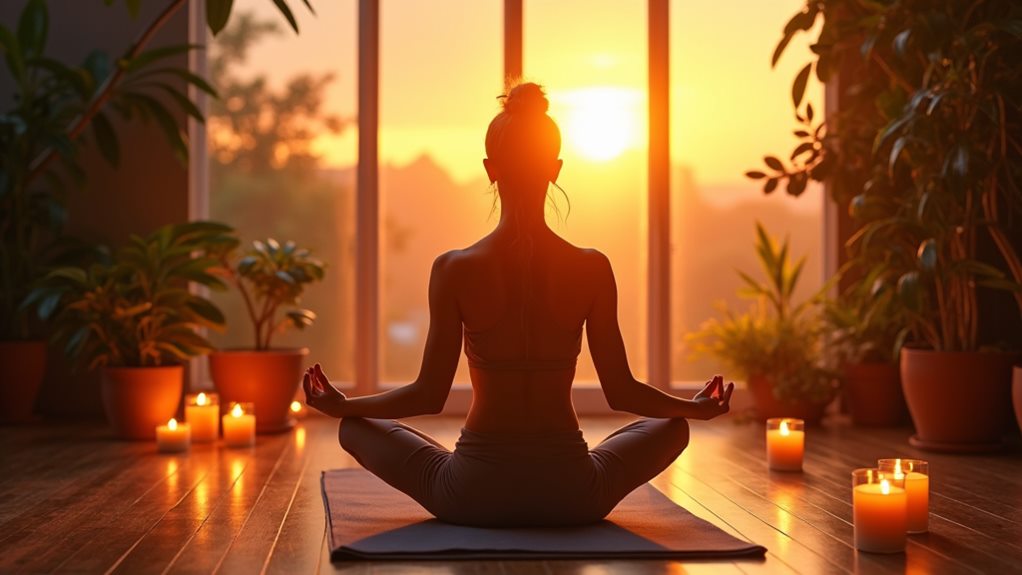
Mindfulness practices in yoga, such as focusing on breath awareness and body sensations, considerably enhance emotional regulation and promote relaxation during your sessions.
By engaging in mindfulness practices, you can experience significant anxiety relief. Incorporating deep breathing techniques like pranayama sends calming signals to your brain, helping lower stress levels and improve focus.
Through these methods, your body alignment improves, akin to actions in Pilates principles, where core engagement enhances awareness of body mechanics. Consistent practice fosters self-awareness and allows you to develop strategies for emotional regulation through mindful movement.
Mindfulness-based yoga sequences offer substantial benefits for anxiety relief:
- Deep Breathing Techniques: Pranayama practices like alternate nostril breathing can help calm your nervous system, enhancing relaxation.
- Mindful Movement: Engage in poses such as Child’s Pose or Legs-Up-the-Wall, which cultivate a sense of calm and grounding. These sequences help you connect your mind and body, reducing anxiousness over time.
- Emotional Regulation: During yoga, focus on body sensations and breath, allowing you to develop emotional regulation skills.
- Self-Awareness: Regular practice deepens your connection with yourself, cultivating awareness of your thoughts and emotions. This helps in recognizing anxiety symptoms earlier, empowering you to manage them effectively.
Incorporating these practices regularly leads to a profound effect on mental health, offering a natural and holistic approach to anxiety relief.
Exploring Restorative Yoga Sequences
When practicing restorative yoga, focus on gentle poses like Child’s Pose and Legs-Up-the-Wall to calm your nervous system and ease anxiety.
Props such as bolsters and blankets will help you hold these poses comfortably for extended periods, maximizing relaxation and support.
Research shows that regularly practicing these poses can lower cortisol levels and boost emotional well-being, making it an effective approach for managing anxiety symptoms.
Benefits of Restorative Practices
Although anxiety can feel overwhelming, restorative yoga offers a gentle and effective pathway to finding peace. By engaging in restorative yoga, you can reduce anxiety, foster deep relaxation, and calm your nervous system.
This practice helps create emotional resilience, allowing you to face life’s challenges more gracefully. Restorative yoga encourages the release of tension both physically and mentally and could bring a new level of mental clarity.
Here are some key benefits you’ll experience with regular restorative yoga practices:
- Calm Nervous System: Longer-held, supported poses help lower cortisol levels, reducing stress and promoting a sense of ease.
- Release Tension: Supported poses facilitate the release of tension from tight muscles, which can often be a physical response to stress.
- Deep Relaxation: By encouraging a state of mindful introspection, restorative yoga brings about profound relaxation, easing the mind from anxious thoughts.
- Emotional Resilience: Consistently practicing restorative yoga builds resilience, helping you tackle stressors more effectively.
Adding poses like Child’s Pose to your routine can enhance these benefits, elevating your emotional and mental well-being.
As research highlights, incorporating these practices considerably reduces anxiety symptoms and enriches your quality of life.
Essential Restorative Poses
Starting on a journey with restorative yoga means delving into poses that prioritize relaxation and stress relief. In these gentle practices, you’ll find the Child’s Pose as a fundamental posture for grounding yourself. It encourages relaxation by folding your body forward, supported by your knees. Use this opportunity to focus on deep breaths, allowing each inhale and exhale to wash away tension.
Restorative yoga places a strong emphasis on comfort, often using props to enhance each pose’s effect. The Reclining Bound Angle Pose and Legs-Up-the-Wall Pose are perfect examples. By staying in these positions for extended periods, your body activates the parasympathetic nervous system, which lowers heart rate and blood pressure.
This activation can greatly aid in anxiety relief and helps in the emotional release of lingering stress.
Incorporating breathwork like deep diaphragmatic breathing is essential. It deepens relaxation and maximizes the calming effects of restorative yoga. Practicing these techniques regularly not only offers anxiety relief but also improves sleep quality and emotional resilience.
Targeting Physical Tension
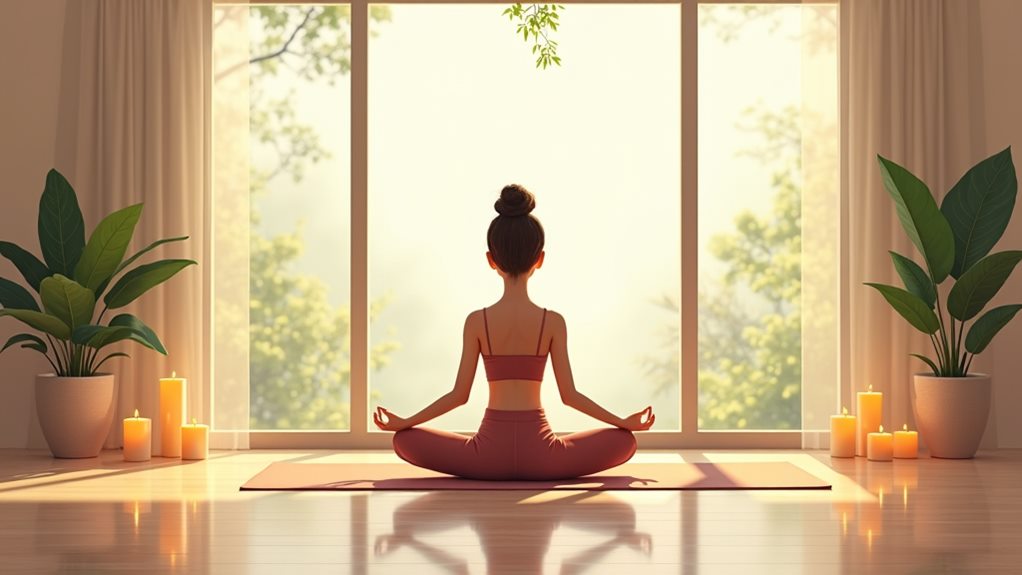
To effectively alleviate physical tension through yoga, focusing on specific poses can make a notable difference. By targeting physical discomfort, you’ll find relief from anxiety and a greater ease in your body. Here’s how:
1. Standing Forward Bend: This pose engages your spinal muscles and hamstrings, helping to release tension and promote relaxation. By folding forward, you’re allowing gravity to help you let go of stress.
2. Child’s Pose: When you practice this pose, you’ll ease stress and fatigue. It’s all about connecting with a deep, calming breath while engaging your gluteus maximus and hamstrings.
It’s a go-to pose for finding tranquility amidst chaos.
3. Extended Puppy Pose: Incorporating this into your routine stretches the spine and targets tension release. You’ll engage your deltoids and erector spinae, encouraging a deeper sense of relaxation that can help you unwind.
4. Triangle Pose: Regular practice can help ease neck and back tension. By targeting your latissimus dorsi and hamstrings, this pose becomes particularly beneficial if you’re experiencing anxiety-related physical discomfort.
Don’t overlook these poses; they’re tools to help you live with a bit more ease and less tension every day.
Complementary Therapies With Yoga
When you’re aiming for anxiety relief, combining yoga with complementary therapies like acupuncture can amplify the benefits.
Consider incorporating weighted blankets to enhance relaxation and explore hypnosis as an additional tool, keeping in mind it often needs professional guidance.
Together, these practices create a thorough approach to managing anxiety more effectively.
Combining Yoga With Acupuncture
How can you enhance your anxiety relief routine? One effective way is by combining yoga with acupuncture. This holistic approach can help reduce symptoms of anxiety disorder, complementing yoga and breathing techniques that help ease emotional regulation.
Engaging in physical movement through yoga and using acupuncture to stimulate specific points on your body can amplify the reduction of stress and anxiety.
Integrating these two therapies can be particularly beneficial because they both aim to balance your body’s energy and improve your overall well-being.
Here’s how you can incorporate this combination into your routine:
- Start with Yoga: Begin your session with yoga to loosen up your body and mind. Focus on breathing techniques to settle your nerves.
- Schedule Acupuncture Post-Yoga: Practicing yoga before your acupuncture session can increase your body’s receptiveness to the treatment, enhancing the benefits for anxiety management.
- Seek Professional Guidance: Work with a certified yoga instructor and a licensed acupuncturist to tailor your sessions for maximum impact.
- Stay Consistent: Regularly combining both therapies can lead to greater reductions in stress hormones like cortisol, improving your mood and emotional stability.
This strategy offers a thorough path towards achieving emotional and mental wellness.
Incorporating Weighted Blankets
After enhancing your anxiety relief routine with the combination of yoga and acupuncture, consider adding weighted blankets to your regimen. These blankets offer deep pressure stimulation, which encourages your body to release serotonin and melatonin, essential hormones for relaxation. This practice can simultaneously decrease cortisol levels, a stress hormone, helping you manage feelings of anxiety more effectively.
Integrating weighted blankets into your yoga for anxiety routine can significantly improve post-practice relaxation, especially during restorative yoga poses like Savasana. The comforting weight of the blanket enhances your relaxation response by creating a soothing environment that encourages complete recovery.
It’s not just about comfort but fostering a deep sense of safety and security that’s fundamental for emotional regulation.
Using weighted blankets during meditation can intensify the benefits of mindfulness practices. By complementing your therapy with these blankets, you’re likely to experience a deeper relaxation response, further reducing anxiety symptoms.
Studies even suggest that using weighted blankets at night can lead to better sleep quality, reinforcing the calming effects engendered during daytime yoga sessions.
Explore this combination and notice how your overall feelings of calmness and balance improve, making it an essential part of your self-care toolkit.
Exploring Hypnosis Benefits
Exploring hypnosis as a complementary therapy alongside yoga offers a compelling approach to managing anxiety effectively. Hypnosis has gained popularity for its remarkable impact on anxiety symptoms when paired with yoga. By engaging in hypnotherapy, you can experience significant anxiety reduction, with some studies highlighting up to a 70% improvement in symptoms.
This therapy works by transforming the subconscious mind’s reactions to various stressors, thereby promoting profound relaxation and enhancing your emotional regulation skills.
Here’s why you should consider combining hypnosis with your yoga practice:
- Amplified Relaxation: Hypnosis deepens the relaxation you achieve through yoga, helping you unwind more thoroughly.
- Personalized Therapy: Sessions can be tailored to your specific needs, targeting unique anxiety triggers, which is highly beneficial when practicing yoga.
- Improved Coping Mechanisms: Combining both practices strengthens your ability to cope with anxiety by reinforcing positive behaviors and thoughts.
- Holistic Wellness: Together, they offer a well-rounded approach, addressing both the physical and mental facets of anxiety relief.
If you’re seeking a way to enhance your yoga routine and reduce anxiety, integrating hypnosis as a therapy could be an excellent choice.
Research on Yoga’s Impact
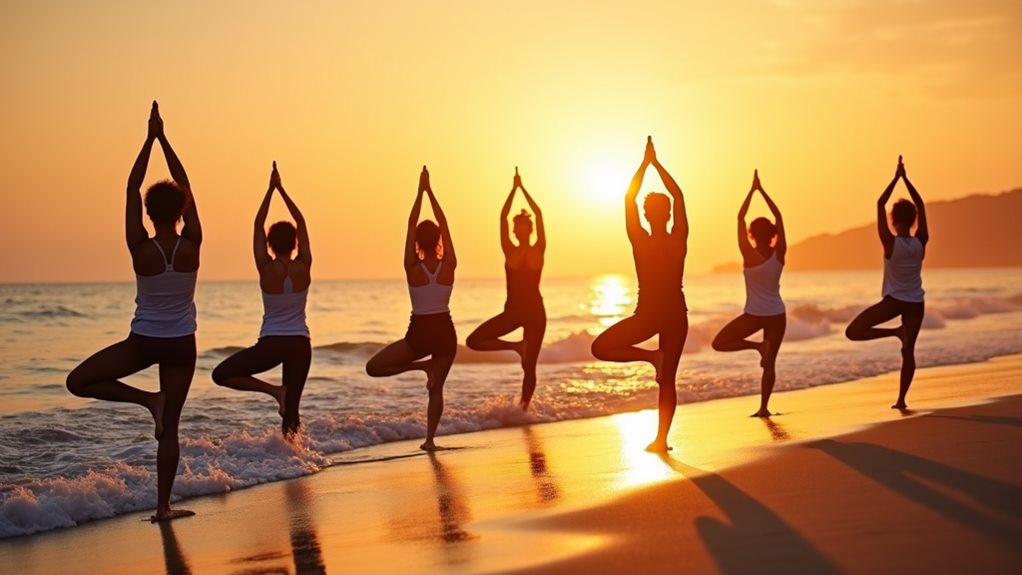
Yoga’s impact on anxiety relief has been the focus of various research studies, revealing its notable benefits. You might have noticed that consistent yoga practice can lead to immense relief from anxiety and stress. Practicing hatha yoga, in particular, could reduce blood pressure and boost self-confidence, showcasing yoga’s physiological advantages. Plus, it fosters emotional regulation, which considerably lessens emotional reactivity and overall anxiety.
An extensive table helps illustrate these benefits:
| Benefit | Physiological | Emotional |
|---|---|---|
| Anxiety Reduction | Lower blood pressure | Improved regulation |
| Stress Management | Enhanced vagal tone | Alleviated reactivity |
| Increased Confidence | Lowered physiological | Boosted self-esteem |
| Relaxation and Recovery | Stimulates parasympathetic | Faster relaxation |
Across diverse populations, research consistently indicates that yoga slashes anxiety symptoms, with a meta-analysis declaring a moderate effect size. This aligns with studies showing that yoga elevates vagal tone and triggers the parasympathetic system, accelerating your relaxation response. Additionally, systematic reviews argue in favor of incorporating yoga interventions alongside conventional anxiety treatments, underscoring its positive role in mental health care frameworks. So, when you practice yoga regularly, you’re not just relaxing your muscles—you’re rejuvenating your mind and mood too.
Practical Tips for Consistent Practice
When looking to incorporate yoga as a consistent practice for anxiety relief, it’s essential to establish a few practical strategies. By setting clear intentions and following a structured plan, you can maximize the benefits of yoga and improve your emotional resilience. Here’s how you can get started:
- Establish a Regular Schedule: Commit to practicing yoga at specific times each week, aiming for at least three sessions. A regular schedule not only enhances emotional resilience but also helps reduce anxiety symptoms over time.
- Create a Dedicated Space: Designate a quiet, distraction-free area in your home for your yoga practice. This dedicated space will serve as your calming sanctuary, making it easier to relax and focus on mindfulness.
- Incorporate Targeted Poses: Use poses like Child’s Pose and Legs-Up-the-Wall to address tension areas associated with anxiety. Pairing these with breathe techniques, like diaphragmatic breathing, can greatly increase relaxation.
- Journal to Track Progress: Keep a journal to record your yoga sessions and emotional responses. This will reinforce the benefits of your practice and keep you motivated to maintain consistency.

